Chapter 2: External Strategic Alternatives
|
OUR OBJECTIVE in this chapter is to get a deeper understanding of external Strategic Alternatives. These are initiatives that involve tapping outside sources to increase value. Our focus will be on mergers and acquisitions (M&A) and outsourcing—two common external SAs that are prevalent and have questionable track records for success. One reason for the weak track record is the ill-formed linkage between the value proposition and shareholder value. The rationale for many mergers is predicated on "strategic reasons" that are not validated from a financial perspective. These strategic reasons tend to have a destructive influence on the business as a whole because the benefit streams are not adequately forecasted and the risks are not well articulated. Outsourcing alternatives are especially popular during economic downturns, but can trade short-term savings for long-term value. These arrangements tend to be used as a stopgap measure to satisfy short-term demands of institutional investors and industry analysts. They tend to be justified by short-term expense reduction. Outsourcing can be more expensive in the long run and create risks for the long-term viability of the business. Our focus will be on a description of these alternatives and the factors that determine success and failure—more specifically their rationale and risks. Let's begin by looking at M&A.
Mergers and Acquisitions
Business combinations and acquisitions are one of the most broadly used methods to execute strategy.
Mergerstat, an authority on M&A, tracks activity in this area. Their results over thirty years show increasing deal value (market value) over time (Exhibit 2-1). In addition, the number of mergers increased over time. There is a tendency for deal making to increase in times of economic expansion, both in number and in value. This is especially evident between 1994 and 1999. During recessionary periods activity tends to decline.
Exhibit 2-1: Value of mergers and acquisitions.
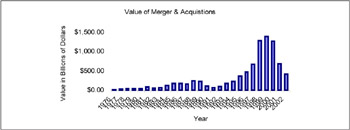
What are the implications of increasing deal value? The obvious conclusion to be drawn is that the sellers are getting wealthier. The seller's shareholders benefit from these price premiums, but the benefit to the acquiring company is not as clear. In a M&A strategy, the key question for the acquiring company is: How is shareholder value enhanced through buying companies? Let's look for answers in the rationale for mergers and acquisitions.
Rationale for Mergers and Acquisitions
Mergers and acquisitions can become extremely complex. Transactions require expertise from strategic, legal, financial, and operational disciplines to be successful. Each of these groups may have different criteria for success. There are many cases where deals are structured to hurdle tax and regulatory barriers. While these factors are beyond the scope of this book, it is important to understand that these issues introduce transactional complexities into the deal. Our view is purely strategic in nature, and our concern is limited to how mergers and acquisitions can deliver shareholder value through improving the strategy and operation of the business. To simplify the analysis, M&A can be rationalized in three ways: 1) competitive integration, 2) supply chain movements, and 3) diversification.
Competitive Integration
Competitive integration occurs when companies in the same business—offering similar products and services to the same target market—combine. An example of this type was the merger of Daimler-Benz and Chrysler. Competitive integration mergers and acquisitions reduce the number of competitors in an industry. This increases the market position of the combined company. The primary strategic benefits of competitive integration are increased size, creating the perception that a company has a greater market presence (market share), superior resources, and improved economies of scale. As enterprises grow in size through this strategy, other competitors will seek to combine driven by growing sense of competitive weakness. The underlying assumption is that bigger is better. This type of thought process has led to a tremendous change in the banking industry as reflected in this excerpt from the Federal Reserve Bulletin on "Profits and balance sheet developments at U.S. commercial banks in 1998":
Bank consolidation continued and included some particularly large mergers. As a result, the share of industry assets at the largest one hundred banks rose to 70 percent at year end, up from 67 3/4 percent a year earlier and around 50 percent in 1985. The number of commercial banks fell by 371, as the number of newly created banks was more than offset by the 588 banks that ceased to exist [almost entirely because of mergers]. At the end of 1998, there were 8,817 commercial banks in the United States, more than one-third fewer than the 14,393 banks that existed in 1985. Banking industry consolidation was also evident in mergers between holding companies, whose numbers declined by 139 last year, to 5,971. The largest fifty holding companies continued to steadily increase their share of industry assets, from 74 percent at the end of 1997 to 76 percent at the end of last year.[1]
Exhibit 2-2 is a sketch of how value is driven by competitive integration M&A. The two primary drivers of competitive integration mergers are revenue increase and operational efficiency. Revenues are increased dramatically through acquisition. This is evident in the exhibit as the revenues for the combined entity are significantly larger than company A and company B. Executives feel that increased market share and geographic presence will enhance the prospect for growth of the combined entity. Operational efficiency results from improved economies of scale. Since both companies are in the same line of business, their operations can be integrated to become more efficient. Unit costs decline, thereby increasing profitability. The dark green bar depicts the profit improvement from economies of scale.
Exhibit 2-2: Driving value through horizontal M&A.
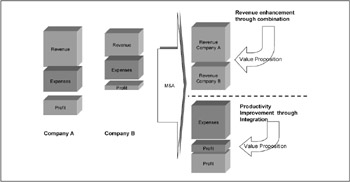
Supply Chain Movement
Supply chain movement M&A is a combination of a company and its buyers or suppliers. General Motors buying an auto parts manufacturer would be an example of a supply chain movement merger. This type of merger allows the acquiring company to reach across the supply chain and take advantage of the benefits available to its trading partners. Supply chain movement mergers and acquisitions typically take one of two forms: 1) supplier acquisitions or 2) buyer acquisitions (see Exhibit 2-3). Shareholder value is derived from supplier acquisitions because these acquisitions eliminate cost layers for materials and services. Shareholder value is derived from buyer acquisitions because these acquisitions enable companies to sell in their markets with lower cost structures and serve the end customer in the supply chain.
Exhibit 2-3: Supply chain movement.
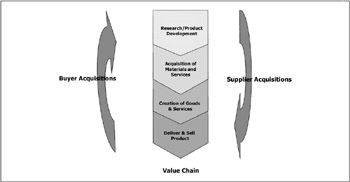
Supplier Acquisitions
Through supplier acquisitions, margins can be improved by reducing the cost of goods sold. To illustrate, let's look at how a supply chain movement acquisition would improve the cost of production of a hypothetical apparel designer, Ann's Enterprises. The average garment sells for sixty dollars. The total cost per unit is forty dollars. The components of the costs are designated in Exhibit 2-4.
Exhibit 2-4: Design example.
| Fabric | $ 5 |
| Production | $20 |
| Design | $ 5 |
| General and Administrative | $10 |
| Total | $40 |
The designer relies on a jobber to produce the clothing at twenty dollars per garment (manufacturing). As illustrated in Exhibit 2-5, the jobber has a cost of production of ten dollars and profit of ten dollars per garment. By purchasing the jobber, unit profits would increase to thirty dollars per garment since the jobber profit has been eliminated. The value proposition is the shift of the jobber profit to the designer as shown by the curved arrow. Value is driven through an improved efficiency as unit profit increases.
Exhibit 2-5: Supply chain movement and cost reduction.
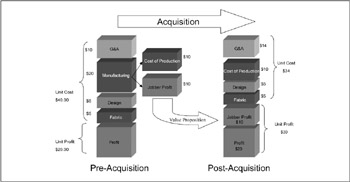
Buyer Acquisitions
Buyer acquisitions produce a competitive advantage by enabling a company to sell to its customers at a lower price. The advantages are lower cost (similar to supplier acquisitions) and better access to materials. To illustrate, let's look at what would happen if a microchip maker bought a cell phone manufacturer. The buyer would have faster access to new components and improved control over inventory.
Many companies use mergers and acquisitions as a method of outsourcing research and development. From a strategic perspective, supply chain movement acquisition provides companies with a method of acquisition of fresh intellectual capital and new products. This can help reduce competition by capturing new innovation that solidifies market share. Companies may also gain access to substitute products (other product lines not within the current product mix) through acquisition. This strategy is extremely effective in fluid markets such as high tech. The variety of products and speed of change has made it difficult to continually innovate cutting-edge solutions. This type of activity is common in the software industry. Peoplesoft Enterprise Resource Planning software recognized the need to expand its suite of applications to include data presentation capabilities. Peoplesoft's product mix included software solutions for human resources, financial, and e-business applications. Peoplesoft purchased a company called Vantive to extend its product line into data presentation. Product line expansion is also a method of diversification, which we will discuss later in this chapter. It mitigates the risk of having a single product and eliminates pressure from substitute products in the marketplace. It is prevalent in industries that have high levels of product evolution (see Exhibit 2-6).
Exhibit 2-6: R&D outsourcing and the supply chain.

Diversification
Diversification mergers and acquisitions are combinations of businesses in unrelated industries. One example of this type of business combination is a pickle manufacturer buying a software company. These companies do not compete against each other and are not in the same industry. The strategic issue addressed by diversification combinations is industry risk. The underlying concept behind diversification activity is closely aligned with holding a portfolio of diversified stocks. Investment risk is being spread across numerous industries (see Exhibit 2-7). Lack of performance due to industry conditions in one industry can be offset by superior returns in another. Diversification mergers mitigate the impact of forces emanating from industry pressures by spreading risk across multiple industries or markets. General Electric is a leader in diversification through mergers and acquisitions. It is involved in a diverse set of businesses—from medical equipment to financial services. In the case of the acquisitive pickle manufacturer, its exposure to pressures from suppliers of cucumbers declines because it is less reliant on revenues and profits from pickles. The primary value proposition is driven by revenue increases and a more sustainable cash flow.
Exhibit 2-7: Diversification and investment.
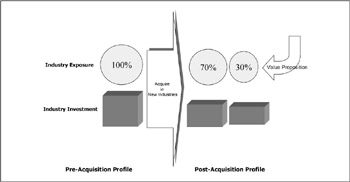
Value from diversification combinations may also be derived from efficiency gains. Economies of scale can be attained through integration of business sustaining functions such as finance and human resources. These synergies may not be as great as competitive integration because business-sustaining functions may be specialized within industries. A bank has different reporting requirements than a biotechnology company. The improvement comes from elimination of duplicated functions. A combination of two companies may lead to elimination of administrative staff such as accounting personnel. If both companies have one hundred people in their accounting departments, they may be able to perform the combined accounting function with 120 workers. This results in savings of eighty employees. The elimination of workers, fixed assets, and other duplicated resources leads to an overall reduction of operating expenses in the long run. This assumes that the function performed requires no specialized knowledge of the specific industries.
Risks of Mergers and Acquisitions
There are three distinct risks to mergers and acquisitions: 1) lower interim productivity, 2) completion, and 3) realization of benefits. Each of these risks can be influenced by many factors.
Interim Efficiency Loss
All mergers and acquisitions require operational change that may temporarily compromise short-term financial performance. However, shareholder demand for short-term results in the form of increased earnings from the business combination does not wane. It is critical that the combined business gets to its target margins as soon as possible. This is why the stock of the acquiring company will normally go down after a merger announcement. Effectively managing this risk of efficiency loss is critical to a successful M&A strategy. The impact of these pressures on the ability to integrate effectively underscores the need for accurate forecasting. This is not to say that there will not be variances to budget, but estimates need to be within a gross order of magnitude. Painting an overly optimistic picture of the expected results from mergers and acquisitions can be the worst enemy of the integration team.
M&A Completion
The initial stages of the M&A process are time-consuming and expensive. In most cases, they involve the most talented individuals in the company. As these individuals are pulled away from their day-to-day responsibilities, business operations may suffer. These efforts are lost if the company cannot identify and successfully close on the appropriate targets. In addition, many transactions are structured with break-up fees if the deal is not consummated.
Realization of Benefits
This issue is at the heart of managing value in a merger. The central question is: When the integration is completed, will the acquirer attain the benefits they envisioned in the strategy and rationale stage of the M&A process? Normally, lower interim productivity is recognized as a risk and accepted by management and shareholders. However, patience wears thin as:
-
Synergies are not realized. Webster defines synergy as "combined action or operation".[2] Synergies should dramatically improve the competitive position of both firms. Examples of synergies are complementary sales channels, improved market share, supply chain efficiencies, and improved product lines. If the synergies are not compelling or attainable, the deal should not be done.
-
Financial returns are weakened. There is an opportunity for efficiency improvement in all types of mergers (Exhibit 2-8). However, the potential for productivity improvement, and the resulting cost savings, is much greater when the companies have similar processes and technologies.
Exhibit 2-8: Financial returns.
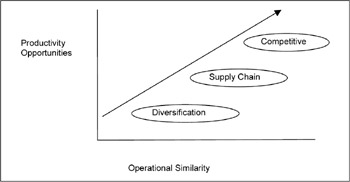
Combinations that are driven by diversification can target business-sustaining functions such as finance and human resources as potential areas for cost reduction. Competitive mergers have the greatest opportunity in this area because the organizations have similar supply chains. This can improve margins and cut costs per unit. The risk is that fixed costs normally increase to support a larger organization. If revenues soften, then profits will decline and margins weaken. Many mergers are predicated on overly aggressive cuts in expenses that cannot be realized. The causes are unattainable expectations and inability to judge the savings opportunity.
Summary: Mergers and Acquisitions as a Strategic Alternative
Mergers and acquisitions can be rationalized in three ways. Companies merge to achieve competitive integration, supply chain movement, and diversification. Competitive integration is done to increase revenue and take advantage of synergies. Supply chain movements help improve margins, lock up new innovations in the marketplace, and provide access to end customers in the supply chain. Diversification helps companies reduce their exposure to specific industries. The major risks of M&A are the inability to realize economies of scale from synergies, consummation of the transactions themselves, and lower interim productivity that ultimately result in weakened financial performance.
[1]Antuilo Bomfirm and William R. Nelson, "Profits and Balance Sheets Developments at U.S. Commercial Banks", Federal Reserve Bulletin, Vol. 85, No. 6 (June 1999), pp. 369-395.
[2]Merriam Webster's Collegiate Dictionary, 10th ed. (1999).
|
EAN: 2147483647
Pages: 117